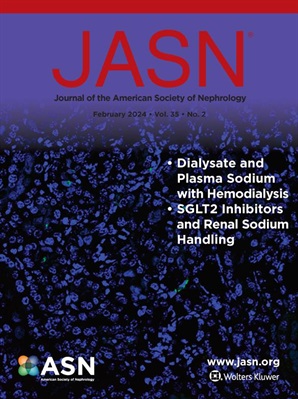Higher versus Lower Phosphate Targets for Patients Undergoing In-Center Hemodialysis: A Randomized Controlled Trial.
IF 9.4
1区 医学
Q1 UROLOGY & NEPHROLOGY
引用次数: 0
Abstract
BACKGROUND Serum phosphate targets in maintenance hemodialysis are based on observational studies. The HiLo trial aimed to compare the effect of a higher versus a lower phosphate target on clinical events in patients receiving maintenance hemodialysis. METHODS HiLo was a pragmatic, multicenter randomized trial that compared higher (≥6.5 mg/dl; "Hi") versus lower (<5.5 mg/dl; "Lo") phosphate targets in patients undergoing maintenance hemodialysis. The goal was to enroll 4400 cluster-randomized patients to assess the primary hierarchical composite outcome of all-cause mortality, followed by all-cause hospitalization using the win ratio. Due to an imbalance in baseline serum phosphate between groups, raising concern for biased recruitment due to post-randomization consent, HiLo transitioned to individual randomization 23 months after the trial began. Ultimately, HiLo was stopped early due to insufficient enrollment and inadequate phosphate separation between groups. For this report, we combined the cluster- and individually randomized cohorts, analyzing the individually randomized cohort as two additional clusters and applying a variance inflation factor to account for site-level clustering effects. RESULTS Between March 2020 and November 2023, 352 patients in the Hi group and 441 in the Lo group were enrolled. After a median follow-up of 1.4 years (quartiles 1, 3: 0.5, 2.8 years), there were 11 deaths per 100 person-years in the Hi group and 13 per 100 person-years in the Lo group. The Hi group experienced 134 hospitalizations per 100 person-years compared to 96 per 100 person-years in the Lo group. The primary hierarchical composite outcome did not differ between groups (win ratio for Hi versus Lo targets was 0.97; 95% confidence interval, 0.55-1.71). CONCLUSIONS Insufficient enrollment and inadequate phosphate separation between groups preclude inferences about the effects of phosphate targets on clinical outcomes.中心血液透析患者较高或较低的磷酸盐靶标:一项随机对照试验。
背景:维持性血液透析的血清磷酸盐靶点是基于观察性研究。HiLo试验旨在比较高磷酸盐靶点与低磷酸盐靶点对接受维持性血液透析患者临床事件的影响。方法shilo是一项实用的多中心随机试验,比较较高(≥6.5 mg/dl;“Hi”)与较低(<5.5 mg/dl;维持性血液透析患者的磷酸盐靶点。目的是招募4400名集群随机患者,评估全因死亡率的主要分层复合结局,然后使用赢比评估全因住院。由于各组之间基线血清磷酸盐的不平衡,引起了对随机化后同意的偏倚招募的担忧,HiLo在试验开始23个月后过渡到个体随机化。最终,由于入组不足和组间磷酸盐分离不充分,HiLo被提前终止。在本报告中,我们结合了集群和个体随机队列,将个体随机队列作为两个额外的集群进行分析,并应用方差膨胀因子来解释站点级别的聚类效应。结果2020年3月至2023年11月,Hi组352例,Lo组441例入组。中位随访1.4年(1、3、0.5、2.8年)后,Hi组每100人年有11例死亡,Lo组每100人年有13例死亡。Hi组每100人年住院134次,而Lo组每100人年住院96次。主要分级综合结局在两组间无差异(Hi与Lo目标的胜比为0.97;95%置信区间为0.55-1.71)。结论充分的入组和不充分的组间磷酸盐分离排除了磷酸盐靶点对临床结果影响的推断。
本文章由计算机程序翻译,如有差异,请以英文原文为准。
求助全文
约1分钟内获得全文
求助全文
来源期刊
CiteScore
22.40
自引率
2.90%
发文量
492
审稿时长
3-8 weeks
期刊介绍:
The Journal of the American Society of Nephrology (JASN) stands as the preeminent kidney journal globally, offering an exceptional synthesis of cutting-edge basic research, clinical epidemiology, meta-analysis, and relevant editorial content. Representing a comprehensive resource, JASN encompasses clinical research, editorials distilling key findings, perspectives, and timely reviews.
Editorials are skillfully crafted to elucidate the essential insights of the parent article, while JASN actively encourages the submission of Letters to the Editor discussing recently published articles. The reviews featured in JASN are consistently erudite and comprehensive, providing thorough coverage of respective fields. Since its inception in July 1990, JASN has been a monthly publication.
JASN publishes original research reports and editorial content across a spectrum of basic and clinical science relevant to the broad discipline of nephrology. Topics covered include renal cell biology, developmental biology of the kidney, genetics of kidney disease, cell and transport physiology, hemodynamics and vascular regulation, mechanisms of blood pressure regulation, renal immunology, kidney pathology, pathophysiology of kidney diseases, nephrolithiasis, clinical nephrology (including dialysis and transplantation), and hypertension. Furthermore, articles addressing healthcare policy and care delivery issues relevant to nephrology are warmly welcomed.

 求助内容:
求助内容: 应助结果提醒方式:
应助结果提醒方式:


